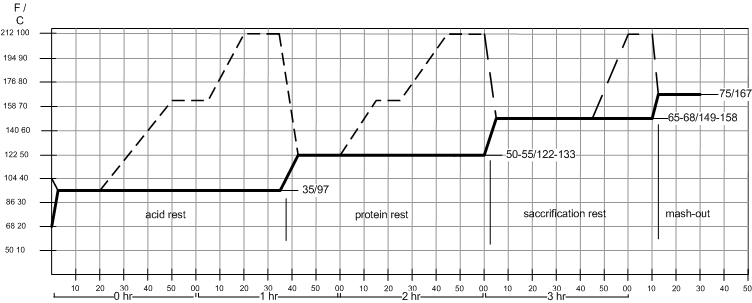Decoction Mashing Video - Transcript
This page serves as the script and then later as the transcript for the decoction mashing video.
introduction
Me talking
Welcome to this instructional video for decoction mashing. This video is not intended to show all the steps necessary for a deoction mashing all grain brewday. Only the the additional steps for decoction mashing are shown. We will start at dough-in and end with the start of the lauter
show slides of olden day brewers decoction mashing
The original deoction mash is the triple decoction, which is called Dreimaischverfahren in German. When it was first used it revolutionized brewing. The repeated pulling, boiling and returning of a part of the mash allowed 2 things. The temperature of the protein, saccrification and mash-out became consistent without the use of a thermometer. But at that time it was not known why that was necessary for consistent beer quality. The repeated boiling of the mash also helped to break down the cell walls and therefore make up for insufficient or inconsistent malting of the grain
show the triple decoction diagram
A triple decoction starts with a dough-in at the acid rest. This rest is held around 35 *C or 97 *F and primarily allows the enzyme phytase to create phytic acid which serves to acidify the mash beyond the acidification that is already happening from a reaction between the Calcium, magnesium and malt phosphates. This rest also serves to dissolve the malt enzymes into solution and provides a no-rush opportunity for mash pH correction since no significant conversion processes are happening at this temperature.
The decoction is pulled and heated
- tripple, double, single decoction
- modern malts
- enhanced double decoction, Hochkurz
- single decoction
- decoction size calculation
- common problems for the home brewer
- commercial decoction mashing
dough-in
[show set-up with strike water heating and MLT]
Here are we and almost ready to dough-in. The malt has been crushed yesterday using a moist conditioning process which helps preserving the husks.
[show the crush]
Which is the reason why the grains look more flattened than crushed. But the endosperm comes right out of the husks. But this is not at all requried for decoction mashing, just a little improvement to my milling process that I started using a while back.
[show the dough-in process once the strike water temp has been reached]
When douging in below the gelatinization temperature of barley starch, which happens between 64-67 C or 147-153 F, you can dump the water onto the grain w/o the risk of getting dough-balls.
[show measuring temperature]
The temperature has nicely settled to ? *C or ? *F and we will now wait a little and measure pH
[show pH measurement]
I took a sample of the wort in this clean bowl and let it cool down. Only measuring cold samples extends the life of the pH meters probe. The ph is now 5.? . Most of the time however, I don't break out the pH meter anymore since it needs to be calibrated before use. These pH measurement strips
[show ph strips]
are perfectly fine. You can make the package go further if you cut them in half or thirds. Oddly enough, the ones I have seem to be reading 0.3 pH units lower than the actual pH. But once I figured this out I started accounting for it.
[show me with beer]
Now I'll have another beer and be back in 10 min to check on the pH of the mash again and maybe do some adjustments if still necessary.
[back measuring pH]'
Over the last 10 min the pH nicely dropped to 5.?. This is fine for me. During that time the enzymes had a chance to get hydrated and dissolved into the mash water.
pulling decoction
[wide angle, show me pulling the 1st decoction]
In order to pull the first decoction I use a strainer and a large measuring cup. With the strainer I scoop out most of the grain and place it into the pot. Then I add mash water until I reach the desired decoction volume
[close-up, the pot with the grain]
To make measuring the volume easier, I notched my mash paddle every 2 liter. And now I have the targeted ? L of decoction. You want to target a decoction mash thickness of about 2 - 2.5 L/kg or 1-1.25 qt/lb. If the mash is to thick, put some of the grain back. Some instructions say that you want the water to barely cover the grain. But I believe that this is way to thick. Such a decoction is difficult to manage and requires constant stiring to prevent it from scorching.
[close-up, adjusting the flame]
The same applies to the flame. Keep it low and heat the decoction gently. German breweries target a rise time of about 1 C or 2 F per minute. I'm fine with going a little faster since I want to be done before dark.
[wide-angle, me and stiring decoction]
- heating up causes starches to gelatinize -> noticable as the mash turns in color and thicker
- amylase liguifies the mash again
- resting
- starch test, conversion problems with Munich malt mashes
- boil, change of color through samples
returning decoction
- temp and pH of the main mash
- protein rest, necessity
- sacc rest
mash-out decoction
- purpose of mash-out
- thin or thick


